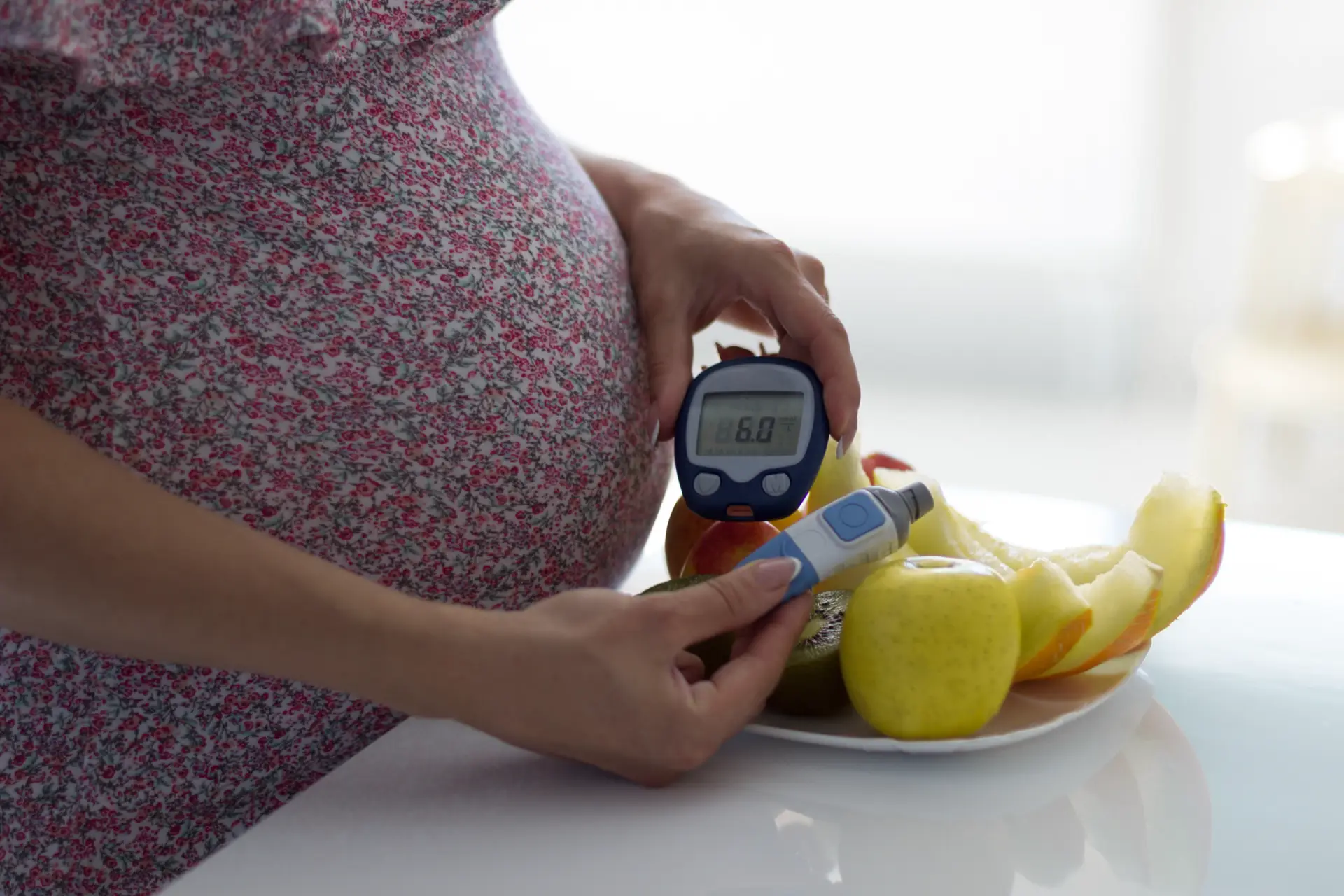An image (a photo) should appear here of a pregnant woman in her first or second trimester with another small child—one of her own—in her lap or nearby having her BG measured by a medical professional, and/or having her blood pressure checked by a medical professional.
Gestational Diabetes Mellitus (GDM) is a type of diabetes that occurs in some women in the second half of their pregnancies (usually after the 20th week), and goes away after their pregnancy ends. It can begin when certain types of hormones are released by the placenta in a mother’s body during pregnancy. These hormones are necessary both to help her nurture the growth of her baby and to keep her healthy. However, sometimes these hormones can also prevent the insulin her pancreas creates from working well enough to move blood glucose, or blood sugar, from her bloodstream into her body’s cells to make the energy she needs, which causes a condition known as insulin resistance. This causes an expectant mother’s body to have to make more insulin to keep her blood glucose (BG) levels in the normal range. As her pregnancy progresses, the levels of these hormones rise, and her insulin resistance gets worse. In high-risk women (as described in the table below), the pancreas cannot keep up with the demands placed on it by the pregnancy, and, because of this, it may not make enough extra insulin to keep BG levels normal. This increase in BG level is known as GDM, or Gestational Diabetes Mellitus.
This would be a good place to have a designed-by-Paige, SIMPLE, infographic/diagram that somehow depicts a pregnant woman—perhaps as a kind of isotype, or a silhouette, so as NOT to be recognizable as any ethnic or racial type—in each of her three trimesters, and, underneath this, a timeline of some sort that depicts “what’s happening” with her hormone levels and BG levels. I’m not sure what this ought to look like/how exactly it might work… I need to defer to Paige on this…
Pregnant women who are at-risk of developing GDM have one or more of the risk factors described below:
The table that appears below should conform physically/typographically to the “house style” to all of the other tables that appear in all of the other EndoMD articles.
| Table 1: Risk Factors for Contracting Gestational Diabetes Mellitus |
| – Being overweight and physically inactive – Being a member of most of the ethnic minorities in the U.S. – Having experienced GDM during a previous pregnancy (40% chance) – Having Polycystic Ovary Syndrome (PCOS) – Being pre-diabetic – Having elevated blood triglyceride levels and depressed HDL-C levels – Having a family history of type 2 diabetes (in a 1st degree relative, such as a father, mother, brother or sister)) – Having previously delivered a baby who weighed more than 9 pounds. – Having high blood pressure |
Once again, we need to be sure that the “typographic look-and-feel” of the table that appears above is THE SAME as the other tables that will be occurring in the articles that will populate the other categories of EndoMD. SO—once again—the typeface family will need to be Fira Sans, the size will need to be (I think 14) and the color scheme that gets deployed will need to be consistent with that of the other tables…
Most women who develop GDM have no symptoms. It can be identified by having your doctor perform a glucose tolerance test (GTT). Usually, this test is performed on pregnant women during the 24th to 28th weeks of their pregnancies.
Criteria for the diagnosis of GDM after the performance of a GTT are:
- Fasting Glucose: greater than or equal to 92 mg/dL4
- One-hour Glucose: greater than or equal to 180 mg/dL
- Two-hour Glucose: greater than or equal to 153 mg/dL
GDM is an important condition for pregnant women to identify, because uncontrolled or unidentified GDM is associated with an increased risk of serious complications for both the mother and her baby (for more information about GDM, please read our article titled “Understanding the Complications that Gestational Diabetes Can Cause”).
- Polycystic ovarian syndrome is a common hormonal condition (roughly 1 in 10 women have it) that affects a woman’s ovaries (the female reproductive organs that produce eggs) during her childbearing years. It can make getting pregnant difficult, as it can stop a woman’s periods or make them difficult to predict.
- Prediabetes happens when someone has elevated blood sugar levels, but they’re not high enough to be considered Type 2 diabetes. People who have blood glucose (sugar) levels between 100 and 125 mg/DL are often diagnosed as being pre-diabetic. Pre-diabetes can be reversed by making healthy lifestyle changes..
- HDL-C is an acronym for “High density lipoprotein cholesterol,” which has come to be known as “good cholesterol.” Cholesterol (there are two types; the other is known as “low-density lipoprotein cholesterol”) is found in all human cells, and is made by the liver. It is necessary to have some of both types for our bodies to work properly, but having too much or too little of either can lead to serious health problems such as heart attacks and strokes.
- Milligrams per deciliter, which is the unit of measurement commonly used to communicate the amount of glucose, or sugar, present in a deciliter (1/10 of a liter) of blood. This is the unit that is most commonly used in the U.S.




